5:11 Rationalize The Denominator International Mathematics 4 Answer Key
Roots and Radicals
76 Divide Square Roots
Learning Objectives
By the end of this section, you will be able to:
- Divide square roots
- Rationalize a one-term denominator
- Rationalize a two-term denominator
Divide Square Roots
We know that we simplify fractions by removing factors common to the numerator and the denominator. When we have a fraction with a square root in the numerator, we first simplify the square root. Then we can look for common factors.

Simplify: ![]() .
.
Solution
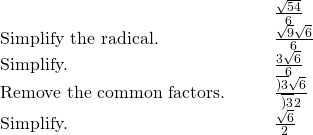
Simplify: ![]() .
.
![]()
Simplify: ![]() .
.
![]()
Simplify: ![]() .
.
Solution
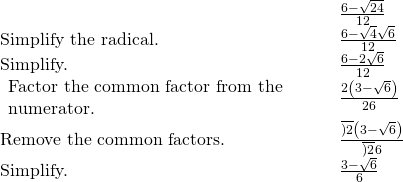
Simplify: ![]() .
.
![]()
Simplify: ![]() .
.
![]()
We have used the Quotient Property of Square Roots to simplify square roots of fractions. The Quotient Property of Square Roots says
![]()
Sometimes we will need to use the Quotient Property of Square Roots 'in reverse' to simplify a fraction with square roots.
![]()
We will rewrite the Quotient Property of Square Roots so we see both ways together. Remember: we assume all variables are greater than or equal to zero so that their square roots are real numbers.
Quotient Property of Square Roots
If a, b are non-negative real numbers and ![]() , then
, then
![]()
We will use the Quotient Property of Square Roots 'in reverse' when the fraction we start with is the quotient of two square roots, and neither radicand is a perfect square. When we write the fraction in a single square root, we may find common factors in the numerator and denominator.
Simplify: ![]() .
.
Solution
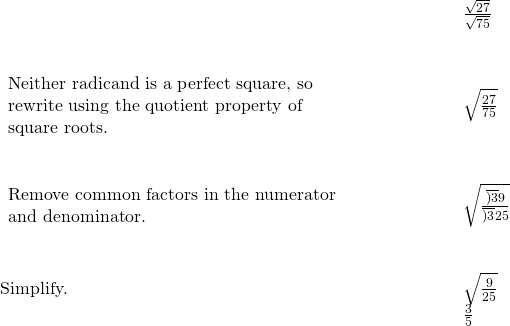
Simplify: ![]() .
.
![]()
Simplify: ![]() .
.
![]()
We will use the Quotient Property for Exponents, ![]() , when we have variables with exponents in the radicands.
, when we have variables with exponents in the radicands.
Simplify: ![]() .
.
Solution
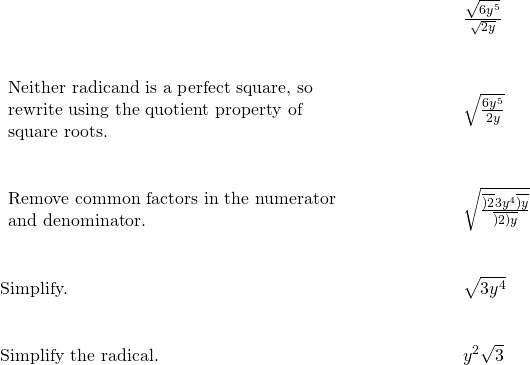
Simplify: ![]() .
.
![]()
Simplify: ![]() .
.
![]()
Simplify: ![]() .
.
Solution
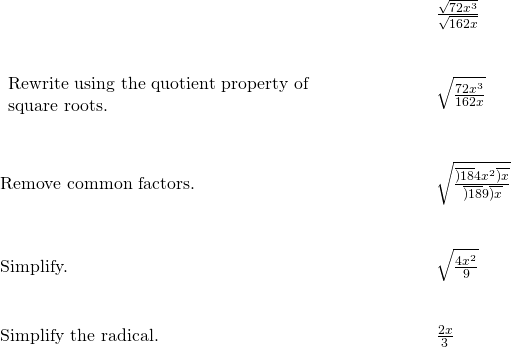
Simplify: ![]() .
.
![]()
Simplify: ![]() .
.
![]()
Simplify: ![]() .
.
Solution
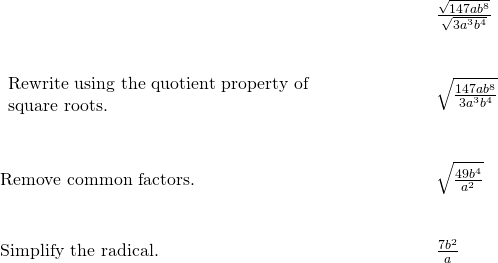
Simplify: ![]() .
.
![]()
Simplify: ![]() .
.
![]()
Rationalize a One Term Denominator
Before the calculator became a tool of everyday life, tables of square roots were used to find approximate values of square roots. (Figure) shows a portion of a table of squares and square roots. Square roots are approximated to five decimal places in this table.
A table of square roots was used to find approximate values of square roots before there were calculators.
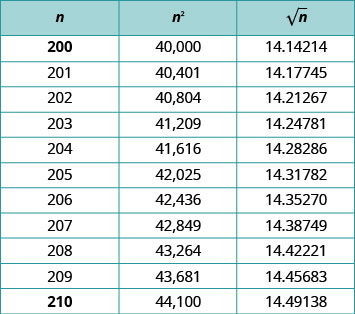
If someone needed to approximate a fraction with a square root in the denominator, it meant doing long division with a five decimal-place divisor. This was a very cumbersome process.
For this reason, a process called rationalizing the denominator was developed. A fraction with a radical in the denominator is converted to an equivalent fraction whose denominator is an integer. This process is still used today and is useful in other areas of mathematics, too.
Rationalizing the Denominator
The process of converting a fraction with a radical in the denominator to an equivalent fraction whose denominator is an integer is called rationalizing the denominator.
Square roots of numbers that are not perfect squares are irrational numbers. When we rationalize the denominator, we write an equivalent fraction with a rational number in the denominator.
Let's look at a numerical example.

But we can find a fraction equivalent to ![]() by multiplying the numerator and denominator by
by multiplying the numerator and denominator by ![]() .
.

Now if we need an approximate value, we divide ![]() . This is much easier.
. This is much easier.
Even though we have calculators available nearly everywhere, a fraction with a radical in the denominator still must be rationalized. It is not considered simplified if the denominator contains a square root.
Similarly, a square root is not considered simplified if the radicand contains a fraction.
Simplified Square Roots
A square root is considered simplified if there are
- no perfect-square factors in the radicand
- no fractions in the radicand
- no square roots in the denominator of a fraction
To rationalize a denominator, we use the property that ![]() . If we square an irrational square root, we get a rational number.
. If we square an irrational square root, we get a rational number.
We will use this property to rationalize the denominator in the next example.
Simplify: ![]() .
.
Solution
To rationalize a denominator, we can multiply a square root by itself. To keep the fraction equivalent, we multiply both the numerator and denominator by the same factor.

Simplify: ![]() .
.
![]()
Simplify: ![]() .
.
![]()
Simplify: ![]() .
.
Simplify: ![]() .
.
![]()
Simplify: ![]() .
.
![]()
Always simplify the radical in the denominator first, before you rationalize it. This way the numbers stay smaller and easier to work with.
Simplify: ![]() .
.
Simplify: ![]() .
.
![]()
Simplify: ![]() .
.
![]()
Simplify: ![]() .
.
Simplify: ![]() .
.
![]()
Simplify: ![]() .
.
![]()
Rationalize a Two-Term Denominator
When the denominator of a fraction is a sum or difference with square roots, we use the Product of Conjugates pattern to rationalize the denominator.

When we multiply a binomial that includes a square root by its conjugate, the product has no square roots.
Simplify: ![]() .
.
Simplify: ![]() .
.
![]()
Simplify: ![]() .
.
![]()
Simplify: ![]() .
.
Simplify: ![]() .
.
![]()
Simplify: ![]() .
.
![]()
Simplify: ![]() .
.
Simplify: ![]() .
.
![]()
Simplify: ![]() .
.
![]()
Simplify: ![]() .
.
Simplify: ![]() .
.
![]()
Simplify: ![]() .
.
![]()
Key Concepts
- Quotient Property of Square Roots
- If a, b are non-negative real numbers and
 , then
, then 
- If a, b are non-negative real numbers and
- Simplified Square Roots
A square root is considered simplified if there are- no perfect square factors in the radicand
- no fractions in the radicand
- no square roots in the denominator of a fraction
Practice Makes Perfect
Divide Square Roots
In the following exercises, simplify.
![]()
![]()
![]()
![]()
![]()
![]()
![]()
![]()
![]()
![]()
![]()
![]()
![]()
![]()
![]()
![]()
![]()
![]()
ⓐ ![]() ⓑ
ⓑ ![]()
![]()
![]()
![]()
![]()
![]()
![]()
![]()
![]()
![]()
![]()
![]()
![]()
![]()
![]()
![]()
![]()
![]()
![]()
![]()
![]()
![]()
Rationalize a One-Term Denominator
In the following exercises, simplify and rationalize the denominator.
![]()
![]()
![]()
![]()
![]()
![]()
![]()
![]()
![]()
![]()
![]()
![]()
![]()
![]()
![]()
![]()
![]()
![]()
![]()
![]()
![]()
![]()
![]()
![]()
![]()
![]()
![]()
Rationalize a Two-Term Denominator
In the following exercises, simplify by rationalizing the denominator.
ⓐ ![]() ⓑ
ⓑ ![]()
ⓐ ![]() ⓑ
ⓑ ![]()
![]()
![]()
![]()
![]()
![]()
![]()
![]()
![]()
![]()
![]()
![]()
![]()
![]()
![]()
![]()
![]()
![]()
![]()
![]()
![]()
![]()
![]()
![]()
![]()
![]()
![]()
![]()
Everyday Math
A supply kit is dropped from an airplane flying at an altitude of 250 feet. Simplify ![]() to determine how many seconds it takes for the supply kit to reach the ground.
to determine how many seconds it takes for the supply kit to reach the ground.
![]()
A flare is dropped into the ocean from an airplane flying at an altitude of 1,200 feet. Simplify ![]() to determine how many seconds it takes for the flare to reach the ocean.
to determine how many seconds it takes for the flare to reach the ocean.
Writing Exercises
ⓐ Simplify ![]() and explain all your steps.
and explain all your steps.
ⓑ Simplify ![]() and explain all your steps.
and explain all your steps.
ⓒ Why are the two methods of simplifying square roots different?
Answers will vary.
Self Check
ⓐ After completing the exercises, use this checklist to evaluate your mastery of the objectives of this section.

ⓑ After looking at the checklist, do you think you are well-prepared for the next section? Why or why not?
Glossary
- rationalizing the denominator
- The process of converting a fraction with a radical in the denominator to an equivalent fraction whose denominator is an integer is called rationalizing the denominator.
5:11 Rationalize The Denominator International Mathematics 4 Answer Key
Source: https://opentextbc.ca/elementaryalgebraopenstax/chapter/divide-square-roots/
Posted by: gouldsump1974.blogspot.com

0 Response to "5:11 Rationalize The Denominator International Mathematics 4 Answer Key"
Post a Comment